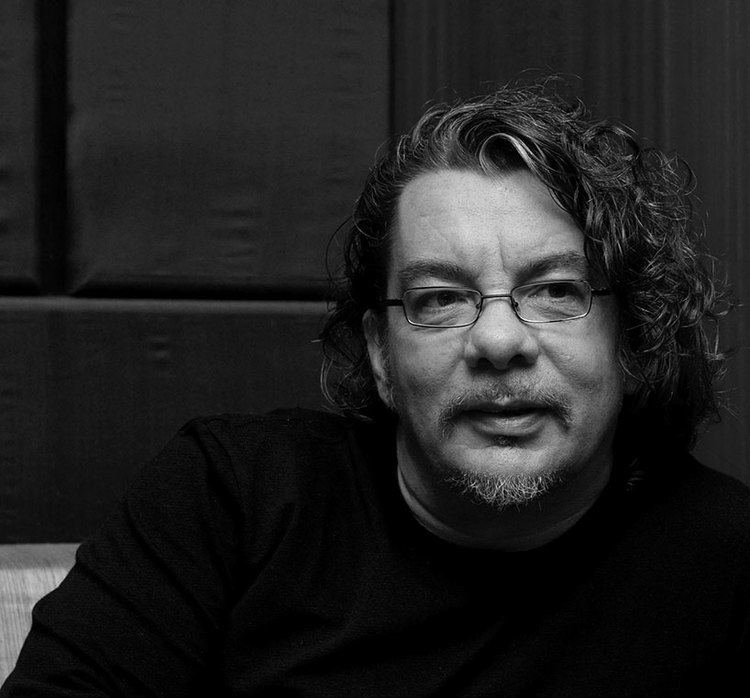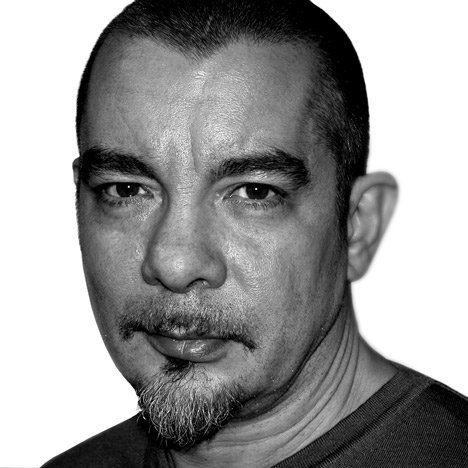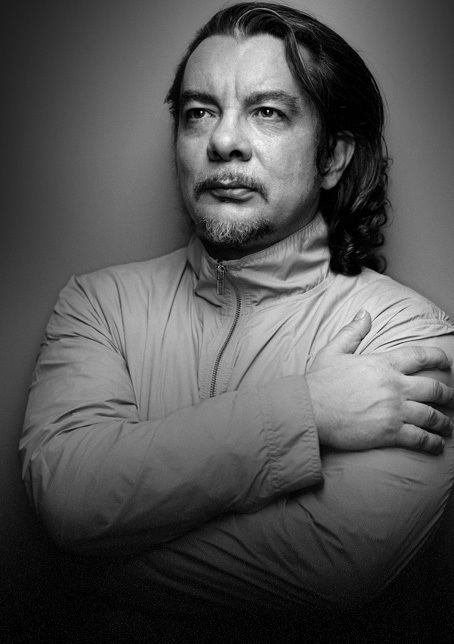Name Neville Brody | ||
 | ||
Books FUSE 1-20, G1: Subj: Contemp. Design, Graphic, G1: New Dimensions in Graphic Design Similar People David Carson, Erik Spiekermann, Stefan Sagmeister, Jon Wozencroft, Paula Scher | ||
Re-evaluating creativity and art - Neville Brody - CDI 2009
Neville Brody (born 23 April 1957) is an English graphic designer, typographer and art director.
Contents
- Re evaluating creativity and art Neville Brody CDI 2009
- Off canvas neville brody
- Early life and education
- 1980s Art Direction
- Business and Typography
- 1994 Present
- Fetish Records
- Cabaret Voltaire
- Other
- Magazine work
- Misc
- Accomplishments
- Fonts by Brody
- References

Neville Brody is an alumnus of the London College of Communication and Hornsey College of Art, and is known for his work on The Face magazine (1981–1986), Arena magazine (1987–1990), as well as for designing record covers for artists such as Cabaret Voltaire, The Bongos, and Depeche Mode. He created the company Research Studios in 1994 and is a founding member of Fontworks. His work is included in the permanent collection of the Museum of Modern Art (MoMA). He is the Head of the Communication Art & Design department at the Royal College of Art, London.

Off canvas neville brody
Early life and education

Born in Southgate, London Neville Brody was a lover of fine art and painting. He had an obsession with art in the 1960s and 1970s. He commented that he does not remember a time in his life when he was planning to do anything other than art or painting. He attended Minchenden Grammar school and studied A-Level Art, very much from a fine art viewpoint. In 1975 Brody went on to do a Fine Art foundation course at Hornsey College of Art, once renowned for its late sixties agitation, now part of Middlesex University.

In autumn 1976, Brody started a three-year B.A. course in graphics at the London College of Printing. His tutors often condemned his work as "Uncommercial", often putting a heavy emphasis on safe and tested economic strategies, as opposed to experimentation.
By 1977, punk rock was beginning to have a major effect upon London life and, while this had a great impact upon Brody's work and motivation, was not well received by his tutors. At one point he was almost thrown out of the college for putting the Queen's head sideways on a postage stamp design. He did, however, get the chance to design posters for student concerts at the college, most notably for Pere Ubu, supported by The Human League.
In spite of the postage stamp episode, Brody was not only motivated by the energies of punk. His first-year thesis had been based around a comparison between Dadaism and pop art.
1980s: Art Direction
Brody's experimentation with his self-made sans-serif typography, along with his Pop Art and Dadaism influence, caught the attention of music record companies such as Fetish Records and Stiff records after he left college. His record cover designs lead toward a grudgy and a punk scene. The album Micro-Phonies by Cabaret Voltaire was art directed by Brody in 1984. His infamous typography features on the front and a bandaged figure spouting liquid from the mouth stares blankly at the viewer.
Brody made his name largely popular through his revolutionary work as an art director for "The Face" Magazine. He changed up the "basic" and "structural" rules that existed in the British culture into a more artsy and vibrant aesthetic. His designs provoked some form of emotion to the extent that people would stick to one page instead of turning pages like they would normally do when reading a novel. Other international magazine and newspaper directions have included City Limits, Lei, Per Lui, Actuel and Arena, together with the radical new look for two leading British newspapers The Guardian and The Observer (both newspaper and magazine). Brody has pushed the boundaries of visual communication in all media through his experimental and challenging work, and continues to extend the visual languages we use through his exploratory creative expression.
In 1988 Thames & Hudson published the first of two volumes about his work, which became the world's best selling graphic design book. Combined sales now exceed 120,000. An accompanying exhibition of his work at the Victoria and Albert Museum attracted over 40,000 visitors before touring Europe and Japan. Amongst countless other projects, in 1989, upon request by the then-director Gerhard Coenen, to Neville Brody, the young Swiss graphic artist and typeface designer Cornel Windlin, then working at the then called "Neville Brody Studio" designed the Corporate Identity for the Haus der Kulturen der Welt (House of World Cultures) in Berlin, Germany. Subsequently, Brody, Windlin, and staff Simon Staines, Giles Dunn and others visited Berlin more than once on projects; resulting in several collaborations with Berlin-based graphic artist and typeface-designer Kolja Gruber and artist Nina Fischer for the Haus der Kulturen der Welt in the following years.
Business and Typography
In 1991, Neville Brody and Jon Wozencroft created the FUSE project. FUSE is an interactive magazine that sets out to challenge our current ideas about typographic and visual language in an age of ever changing communications technology and media. Brody was also partly responsible for instigating the fusion between a magazine, graphics design and typeface design. The magazine ranges in themes from "Codes" and "Runes" to "Religion" and "Pornography." the exploration and freedom that the publishers exhibit is undeniable and exciting. The conventions upturned in FUSE are prescient in their definition of new standards. Each package includes a publication with articles relating to typography and surrounding subjects, four brand new fonts that are unique and revolutionary in some shape or form and four posters designed by the type designer usually using little more than their included font. In 1990 he also founded the FontFont typeface library together with Erik Spiekermann.
Notable fonts include the updated font for the Times newspaper, Times Modern, New Deal as used in publicity material and titles for the film Public Enemies and Industria.
1994-Present
Neville Brody still also continues to work as a graphic designer and together with business partner Fwa Richards launched his own design practice, Research Studios, in London in 1994. Since then studios have been opened in Paris, Berlin and Barcelona. The company is best known for its ability to create new visual languages for a variety of applications ranging from publishing to film. It also creates innovative packaging and website design for clients such as Kenzo, corporate identity for clients such as Homechoice, and on-screen graphics for clients such as Paramount Studios, makers of the Mission Impossible films.
Recent projects include the redesign of the BBC in September 2011, The Times in November 2006 with the creation of a new font Times Modern. The typeface shares many visual similarities with Mercury designed by Jonathan Hoefler. It is the first new font at the newspaper since it introduced Times New Roman in 1932.
The company also completed a visual identity project for the famous Paris contemporary art exhibition Nuit Blanche in 2006.
Brody's team launched a new look for the champagne brand Dom Pérignon in February 2007, having been appointed in 2004 to help the brand with its strategy and repositioning. A sister company, Research Publishing, produces and publishes experimental multi-media works by young artists. The primary focus is on FUSE, the conference and quarterly forum for experimental typography and communications. The publication is approaching its 20th issue over a publishing period of over ten years. Three FUSE conferences have so far been held, in London, San Francisco and Berlin. The conferences bring together speakers from design, architecture, sound, film and interactive design and web.
As of 2017, the welsh WJEC exam board included Neville Brody as part of their Graphic Design curriculum.
Fetish Records
Art Director (1980)
Cabaret Voltaire
Other
Magazine work
Misc
Accomplishments
Fonts by Brody
Brody has designed 21 font families, including:
